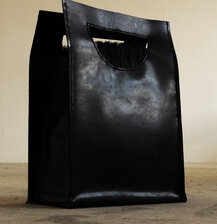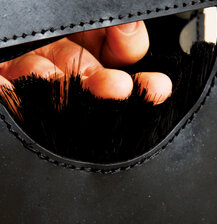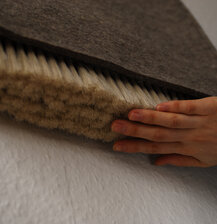Wintersemester 2011/12,
Living with Bristles
When people look at or touch a surface, their sensorial experience is always informed by the knowledge or the imaginations they already connect with them. You rarely have a “pure” feeling of touch, the perception of a tactile surface strongly depends on concepts you link to it. Different contexts of use create different levels of attention and a selective perception of sensorial details. While this filtering and reduction of sensory perception is essential to lead our daily lives, to open it up offers a rich variety of new aesthetic experiences.
Bristles of household brushes and brooms are a material normally associated with cleaning procedures and everyday routines. You don’t know much about how they actually feel and look. Since they are entirely defined through their function, nobody gives any conscious attention to them. Their value is regarded low, and there is no thought of any attraction associated to them or even comfort. Instead, you keep them in a distance, and it is mainly dirt, which they encounter, and not your skin or your visual attention.
This project uses bristles of brooms to show the transformation of a banal, everyday industrial material into an aesthetic and sensual artefact, which can become an attractive and individual element in a personal environment. For this different qualities of bristles were researched and their respective properties examined. Taken away from the broom context, a wide range of appearances and material behaviour got into view and animated for aesthetic experimentation: How would it look in combination with different qualities or other materials, what changes are achieved when appearing isolated from their normal place or even given new shapes, how correlate visual and tactile perception, as what kind of objects could it finally turn out?
Out of these reflections three distinct categories of objects were developed to examine individual properties and show how they can appeal to the senses.
The first category features the aspect of movement. The combination of felt and bristles protruding from it allows to create flexible structures with a very own behavior of the bristle layer, condensing, opening up, twisting and bending and thus literally magnifying the original movement. The diverse possible sequences of motion sometimes appear like an abstract version of animal movements such as caterpillars or hedgehogs.
The second category focuses on irregular patterns, which are applied to a “solid” round base of felt and differ in the way the bristles are distributed over the surface. By using different types of hairs for each object the respective material characteristics in terms of their visual and tactile properties can be examined.
The third category of felt and bristle fusions is about three-dimensional structures. Here always a combination of different types of bristles is involved. Stroking the uneven surface by hand you can discover different regions of softness.
The project is an attempt to alter our everyday experience and shift cheap and ordinary materials into an aesthetic and sensorial context. It shows how by transforming simple elements of our surroundings completely new categories of objects can be created. For example: BAGS.



